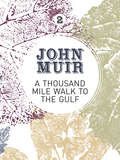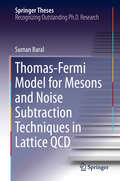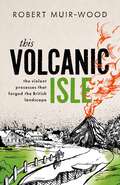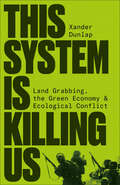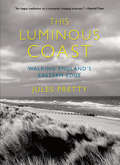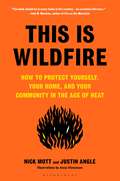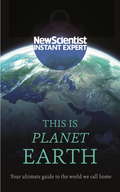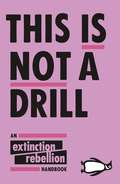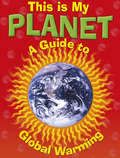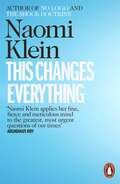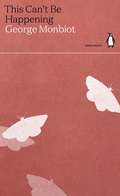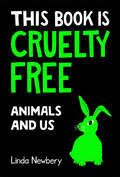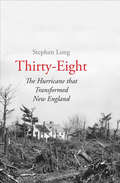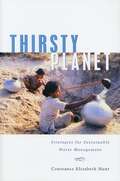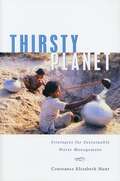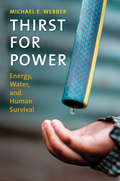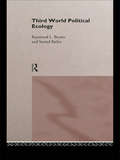- Table View
- List View
A Thousand-Mile Walk to the Gulf: A radical nature-travelogue from the founder of national parks (John Muir: The Eight Wilderness-Discovery Books #2)
by John Muir‘Many a beautiful plant cultivated to deformity, and arranged in strict geometrical beds, the whole pretty affair a laborious failure side by side with divine beauty.’A Thousand-Mile Walk to the Gulf is the second book in John Muir’s Wilderness-Discovery series. It is within this work that we are really given strong clues toward Muir’s future trailblazing movement for environmental conservation, in such comments as ‘The universe would be incomplete without man; but it would also be incomplete without the smallest transmicroscopic creature that dwells beyond our conceitful eyes and knowledge.’Muir’s walk from Indiana to Florida was conceived in order to explore and study further the flora and fauna across states. He undertakes this alone, a dangerous choice perhaps so soon after the civil war, as many characters along the way forewarn. Indeed, Muir is threatened by a robber, and we see a new side to the quiet, lowly gentleman we know as he springs into self-defence mode with lightning initiative and remarkable courage.This is not the only facet of Muir’s personality that is uncovered throughout this journey. He makes reference to feeling ‘dreadfully lonesome and poor’, which is intriguing as his circumstances are self-sought: ‘Stayed with lots of different people but preferred sleeping outside alone where possible’. He spends a substantial period of time struck down with malaria, which does not come as a surprise; he was covering many miles on an unsustainably meagre diet with thirst often quenched with swamp water or not at all.Join Muir in Kentucky forests, Cumberland mountains, Florida swamps and all the elegantly described trees, plants, creatures and rocks in-between. A Thousand-Mile Walk to the Gulf teaches us as much about Muir himself as it does the ecosystems in the wilderness across those 1,000 miles.
Thor's Legions: Weather Support to the U.S. Air Force and Army, 1937-1987
by John FullerThis book provides insight into the air force weather history from 1937 to 1987. Author John F. Fuller recounts the history of the Air Weather Service from World War II to the Vietnam conflict, introducing its courageous family of forecasters who provided vital weather support for the nation's armed forces and made notable contributions to the field of meteorology. It approaches controversial events leading up to the D-Day, Hiroshima and Nagasaki forecasts. “I'd rate the book a"gem" as a reference book, especially for weather historians.” (H. Michael Mogil, NWA, June 6, 1944)
Thomas-Fermi Model for Mesons and Noise Subtraction Techniques in Lattice QCD (Springer Theses)
by Suman BaralThis thesis make significant contributions to both the numerical and analytical aspects of particle physics, reducing the noise associated with matrix calculations in quantum chromodynamics (QCD) and modeling multi-quark mesonic matters that could be used to investigate particles previously unseen in nature. Several methods are developed that can reduce the statistical uncertainty in the extraction of hard-to-detect lattice QCD signals from disconnected diagrams. The most promising technique beats competing methods by 1700 percent, leading to a potential decrease in the computation time of quark loop quantities by an order of magnitude. This not only increases efficiency but also works for QCD matrices with almost-zero eigenvalues, a region where most QCD algorithms break down. This thesis also develops analytical solutions used to investigate exotic particles, specifically the Thomas-Fermi quark model, giving insight into possible new states formed from mesonic matter. The main benefit of this model is that it can work for a large number of quarks which is currently almost impossible with lattice QCD. Patterns of single-quark energies are observed which give the first a priori indication that stable octa-quark and hexadeca-quark versions of the charmed and bottom Z-meson exist.
This Volcanic Isle: The Violent Processes that forged the British Landscape
by Robert Muir-WoodFrom the natural geometry of the Giant's Causeway to the sarsen slabs used to build Stonehenge, we are surrounded by evidence for the extraordinary geological forces that shaped the British Isles. Running coast to coast through Devon is 'Sticklepath', Britain's 'San Andreas', a geological fault with the two sides displaced horizontally by several kilometres, all within the recent geological past. The Sticklepath Fault is just one manifestation of the rich tectonic history of the British region since the asteroid collision that ended the reign of the dinosaurs, 66 million years ago. Raised out of the Chalk Sea, the original Albion was a thickly forested island a thousand kilometres long, surrounded by chalk cliffs, punctuated with great volcanoes, and the site of two trial 'spreading ridge' plate-boundaries. As the volcanoes shifted west, and Greenland separated from Europe, the wind-blown volcanic ash laid the strata on which London was founded. The vertical Needles, known to every Isle of Wight sailor, are part of the northern foothills of the Pyrenees. When the collision subsided, rifting created a garland of Celtic lakes from Brittany to the Outer Hebrides. In This Volcanic Isle Robert Muir-Wood explores the rich geological history of the British Isles, and its resulting legacy. Along the way he introduces the personalities who shared a fascination for Britain's tectonic history, including Charles Darwin the geologist, Tennyson the science-poet, and Benoit Mandelbrot, the pure mathematician who labelled the west coast of Britain a fractal icon. Here is the previously untold story of how earthquakes and eruptions, plumes and plate boundaries, built the British Isles.
This Volcanic Isle: The Violent Processes that forged the British Landscape
by Robert Muir-WoodFrom the natural geometry of the Giant's Causeway to the sarsen slabs used to build Stonehenge, we are surrounded by evidence for the extraordinary geological forces that shaped the British Isles. Running coast to coast through Devon is 'Sticklepath', Britain's 'San Andreas', a geological fault with the two sides displaced horizontally by several kilometres, all within the recent geological past. The Sticklepath Fault is just one manifestation of the rich tectonic history of the British region since the asteroid collision that ended the reign of the dinosaurs, 66 million years ago. Raised out of the Chalk Sea, the original Albion was a thickly forested island a thousand kilometres long, surrounded by chalk cliffs, punctuated with great volcanoes, and the site of two trial 'spreading ridge' plate-boundaries. As the volcanoes shifted west, and Greenland separated from Europe, the wind-blown volcanic ash laid the strata on which London was founded. The vertical Needles, known to every Isle of Wight sailor, are part of the northern foothills of the Pyrenees. When the collision subsided, rifting created a garland of Celtic lakes from Brittany to the Outer Hebrides. In This Volcanic Isle Robert Muir-Wood explores the rich geological history of the British Isles, and its resulting legacy. Along the way he introduces the personalities who shared a fascination for Britain's tectonic history, including Charles Darwin the geologist, Tennyson the science-poet, and Benoit Mandelbrot, the pure mathematician who labelled the west coast of Britain a fractal icon. Here is the previously untold story of how earthquakes and eruptions, plumes and plate boundaries, built the British Isles.
This System is Killing Us: Land Grabbing, the Green Economy and Ecological Conflict
by Xander Dunlap“Dunlap is one of the foremost researchers on the unfolding relationship between ecocide, colonialism, extractivism, and green capitalism. ... An important book” Peter Gelderloos, author of The Solutions are Already Here “Vital for understanding the forces driving violence against land and water defenders around the world” Alleen Brown, investigative journalist“A passionate account of the harms of green capitalism” Professor Anna Feigenbaum, author of Tear Gas“One of the most compelling, demystifying, and provocative calls to action in the face of the violent collapse of modernity. A must-read” Dr. Carlos Tornel, author of Gustavo EstevaThis System is Killing Us is an insider look at the catastrophic effects that energy infrastructure and mining are having on communities and our planet. Xander Dunlap spent a decade living and working with Indigenous activists and land defenders across the world to uncover evidence of the repression people have faced in the wake of untamed capitalist growth.By centring the struggles of people whose lives are being systematically destroyed, Dunlap reveals gaps within the current official debates around climate change. This includes reviewing feuds between socialist modernism and degrowth. While changing public policy could play a constructive role in remediating climate catastrophe, by understanding the successes and failures of those “on the front lines”, it becomes clear that ecologically decentralized self-organization could be the only way out of this environmental nightmare.Xander Dunlap is a postdoctoral research fellow at the Institute for Global Sustainability, Boston University, USA, and a visiting research fellow in the Global Development Studies Department, University of Helsinki, Finland. Xander has written many books, most recently Enforcing Ecocide, and is a long-time participant in anti-police, squatting and environmental movements.
This Luminous Coast: Walking England's Eastern Edge
by Jules PrettyOver the course of a year, Jules Pretty walked along the shoreline of East Anglia in southeastern England, eventually exploring four hundred miles on foot (and another hundred miles by boat). It is a coast and a culture that is about to be lost—not yet, perhaps, but soon—to rising tides and industrial sprawl. This Luminous Coast takes the reader with him on his journey over land and water; over sea walls of dried grass, beside stretched fields of golden crops, alongside white sails gliding across the intricate lacework of invisible creeks and estuaries, under vast skies that are home to curlews and redshanks and the outpourings of skylarks. East Anglia’s coastline is as much a human landscape as it is a natural one, and Pretty is equally perceptive about the region’s cultural heritage and its "industrial wild": fishing villages and the modern seaside resorts, family farms and oil refineries, pleasure piers and concrete seawalls, cozy pubs and military installations. Through words and photographs, Pretty interweaves stories of the land and sea with people past and present. He is a passionate and sensitive guide to a region in transition, under stress, and perhaps even doomed, as finely attuned to its history as he is to its unique sensory world.
This Land of Promise: A History of Refugees and Exiles in Britain
by null Matthew Lockwood‘Important, comprehensive, and superbly researched. All the more urgent at the present time’ BART VAN ES How have those who arrived on Britain’s shores shaped its history? Refugees seeking to reach Britain today often face perilous journeys, impossible bureaucracy and acidic public opinion. But this hasn’t always been the way. For most of our history, Great Britain cherished its outward image as a safe haven for those displaced by religious persecution, political violence or economic crisis – an island of stability in the midst of a violent world. In This Land of Promise, migration scholar Matthew Lockwood overturns many popular modern-day misconceptions about Britain’s history of immigration. Exiles and refugees have been not only a constant presence in Britain across the centuries but also intrinsic to shaping Britain as it is today. This is a profoundly moving and illuminating history, told through the people who lived it: Frederick Douglass and the formerly enslaved men who followed in his footsteps, fleeing America on the hopes of kinder cultures. Little girls like Liesl Ornstein, who discovered they were Jewish only when Hitler took Austria, who were sent to England and told to call themselves ‘Elizabeth’. Sun Yat-sen, who found sanctuary in London – a brief abduction aside – before becoming the father of modern China. Freddie Mercury, who at every turn tried to shake Zanzibar from his bones. Almost every time, we see when we look back, Britain has not been an island refuge from the world, but an island refuge for the world. Not a country burdened by refugees, but instead transformed and strengthened by them.
This Is Wildfire: How to Protect Yourself, Your Home, and Your Community in the Age of Heat
by Nick Mott Justin AngleA practical guide for living with wildfire, including essential history and science, actions you can take to protect your home, and guiding principles for life in an increasingly fiery future.Wildfires are getting more destructive than ever before. Flames in forests are scorching about twice as many trees as they did two decades ago, and nearly 100,000 homes, barns, and other structures have been incinerated. “Fire seasons” are now fire years. Tens of millions of people live in areas vulnerable to fire, and more keep moving in. Driven in part by climate change, the areas burned and prevalence of smoke in the skies is expected to skyrocket in the decades to come. At the same time that wildfires leave swathes of the country in ash, they also renew. Wildfire is crucial for ecosystems to function and flourish. We're putting out many of the fires our landscape needs, and the ones that escape our control are devastating for forests and communities. It's clear what we're doing isn't working. Wildfire is inevitable, and we need to learn to live with it.The first of its kind, This Is Wildfire is required reading for our new reality. It offers everything you need to know about fire in one useful volume: reflects on the history of humanity's connection to flames; analyzes how our society arrived at this perilous moment; and recounts stories of those fighting fire and trying to change our relationship with it. It also offers practical advice: choosing your insurance and making your home resilient to burns; packing an emergency go-bag; rebuilding after a fire; and so much more.
This is Planet Earth: Your ultimate guide to the world we call home (New Scientist Instant Expert)
by New ScientistThe ancient Greeks called it Gaia; the Romans Terra. We know it simply as Earth, the planet we call home. And what a planet it is.Formed around 4.6 billion years ago from the debris of the big bang and long-dead stars, at first it was nothing special, but somehow it evolved to become the most amazing place in the known Universe. The only living planet we know of, it also has a very unusual moon, a remarkably dynamic surface, a complex atmosphere and a deeply mysterious interior.This is Planet Earth is dedicated to the wonders of Planet Earth. Its past is long and dramatic and its future shrouded in mystery. Yet despite centuries of research, only now are we starting to understand Earth's complexity.ABOUT THE SERIESNew Scientist Instant Expert books are definitive and accessible entry points to the most important subjects in science; subjects that challenge, attract debate, invite controversy and engage the most enquiring minds. Designed for curious readers who want to know how things work and why, the Instant Expert series explores the topics that really matter and their impact on individuals, society, and the planet, translating the scientific complexities around us into language that's open to everyone, and putting new ideas and discoveries into perspective and context.
This is only a Test: How Washington D.C. Prepared for Nuclear War
by D. KruglerPlease note this is a 'Palgrave to Order' title (PTO). Stock of this book requires shipment from an overseas supplier. It will be delivered to you within 12 weeks. This book tells the history of nuclear age urban planning, civil defence and continuity of government programs in one of the nation's most critical Cold War targets: Washington, D.C.
This Is Not A Drill: An Extinction Rebellion Handbook
by Extinction RebellionExtinction Rebellion are inspiring a whole generation to take action on climate breakdown. Now you can become part of the movement - and together, we can make history.It's time. This is our last chance to do anything about the global climate and ecological emergency. Our last chance to save the world as we know it. Now or never, we need to be radical. We need to rise up. And we need to rebel.Extinction Rebellion is a global activist movement of ordinary people, demanding action from Governments. This is a book of truth and action. It has facts to arm you, stories to empower you, pages to fill in and pages to rip out, alongside instructions on how to rebel - from organising a roadblock to facing arrest. By the time you finish this book you will have become an Extinction Rebellion activist. Act now before it's too late.
This Is My Planet: This Is My Planet (This Is My Planet #1)
by Jan ThornhillWhy is global warming a problem? How do we know that Earth is heating up? Will climate change affect me? Can we stop it from getting worse? Is there something I can do to help?These are just some of the questions tackled in this intelligent and impassioned book about global warming and its impact on our Earth. By looking at the amazing interconnections between humans and our environment, readers will discover how even small actions can add up to make big changes.
This Changes Everything: Capitalism vs. the Climate
by Naomi KleinNaomi Klein, author of the #1 international bestsellers, The Shock Doctrine and No Logo, returns with This Changes Everything, a must-read on how the climate crisis needs to spur transformational political changeWe seem to have given up on any serious effort to prevent catastrophic climate change. Despite mounting scientific evidence, denialism is surging in many wealthy countries, and extreme fossil-fuel extraction gathers pace. Exposing the work of ideologues on the right who know the challenge this poses to the free market all too well, Naomi Klein also challenges the failing strategies of environmental groups. This Changes Everything argues that the deep changes required should not be viewed as punishments to fear, but as a kind of gift. It's time to stop running from the full implications of the crisis and begin to embrace them. Naomi Klein is an award-winning journalist, syndicated columnist and author of the international bestsellers, The Shock Doctrine and No Logo. She is a member of the board of directors for 350.org, a global grassroots movement to solve the climate crisis, a Puffin Foundation Writing Fellow at The Nation Institute, and a former Miliband Fellow at the LSE. She holds an honorary Doctor of Civil Laws from the University of King's College, Nova Scotia.
This Can't Be Happening (Green Ideas)
by George MonbiotIn twenty short books, Penguin brings you the classics of the environmental movement.In the galvanising speeches and essays brought together in This Can't Be Happening, George Monbiot calls on humanity to stop averting its gaze from the destruction of the living planet, and wake up to the greatest predicament we have ever faced.Over the past 75 years, a new canon has emerged. As life on Earth has become irrevocably altered by humans, visionary thinkers around the world have raised their voices to defend the planet, and affirm our place at the heart of its restoration. Their words have endured through the decades, becoming the classics of a movement. Together, these books show the richness of environmental thought, and point the way to a fairer, saner, greener world.
This Book is Cruelty-Free: Animals And Us
by Linda NewberyIf you've ever wondered how you can make your diet cruelty-free, whether it's ethical to own a pet, or if insects are actually important – this book is for you. Learn how to make the right choices to live a cruelty-free life and demystify the morals and ethics around animals and wildlife.
Thirty-Two Words for Field: Lost Words of the Irish Landscape
by Manchán MaganThe Irish language has thirty-two words for field. Among them are:Geamhar – a field of corn-grassTuar – a field for cattle at nightRéidhleán – a field for games or dancingCathairín – a field with a fairy-dwelling in itThe richness of a language closely tied to the natural landscape offered our ancestors a more magical way of seeing the world. Before we cast old words aside, let us consider the sublime beauty and profound oddness of the ancient tongue that has been spoken on this island for almost 3,000 years.In Thirty-Two Words for Field, Manchán Magan meditates on these words – and the nuances of a way of life that is disappearing with them.
Thirty-Eight: The Hurricane That Transformed New England
by Stephen LongThe hurricane that pummeled the northeastern United States on September 21, 1938, was New England’s most damaging weather event ever. To call it “New England’s Katrina” might be to understate its power. Without warning, the storm plowed into Long Island and New England, killing hundreds of people and destroying roads, bridges, dams, and buildings that stood in its path. Not yet spent, the hurricane then raced inland, maintaining high winds into Vermont and New Hampshire and uprooting millions of acres of forest. This book is the first to investigate how the hurricane of ’38 transformed New England, bringing about social and ecological changes that can still be observed these many decades later. The hurricane’s impact was erratic—some swaths of forest were destroyed while others nearby remained unscathed; some stricken forests retain their prehurricane character, others have been transformed. Stephen Long explores these contradictions, drawing on survivors’ vivid memories of the storm and its aftermath and on his own familiarity with New England’s forests, where he discovers clues to the storm’s legacies even now. Thirty-Eight is a gripping story of a singularly destructive hurricane. It also provides important and insightful information on how best to prepare for the inevitable next great storm.
Thirty-Day Forecasting: A Review of a Ten-Year Experiment (Meteorological Monographs #2)
by Jerome NamiasThe objects of the American Meteorological Society are "the development and dissemination of knowledge of meteorology in all its phases and applications, and the advancement of its professional ideals." The organization of the Society took place in affiliation with the American Association for the Advancement of Science at Saint Louis, Missouri, December 29, 1919, and its incorporation, at Washington, D. C., January 21, 1920. The work of the Society is carried on by the Bulletin, the Journal, and Meteorological Monographs, by papers and discussions at meetings of the Society, through the offices of the Secretary and the Executive Secretary, and by correspondence. All of the Americas are represented in the membership of the Society as well as many foreign countries.
Thirsty Planet: Strategies for Sustainable Water Management
by Constance Elizabeth HuntBy the year 2025 nearly 2 billion people will live in regions experiencing absolute water scarcity. In the face of this emerging crisis, how should the planet's water be used and managed? Current international policy sees nature competing with human uses of water. Hunt takes issue with this perspective. She suggests that nature is the source of water and only by making the conservation of nature an absolute priority will we have the water we need for human use in future. It is essential , therefore, to manage water in ways that maintain the water cycle and the ecosystems that support it.This book looks at the complexity of the problem. It provides a wide array of ideas, information, case studies and ecological knowledge - often from remote corners of the developing world -- that could provide an alternative vision for water use and management at this critical time.Essential and compelling reading for students on courses related to water resource management and development; water managers and decision makers, and non-specialists with an interest in global water issues.
Thirsty Planet: Strategies for Sustainable Water Management
by Constance Elizabeth HuntBy the year 2025 nearly 2 billion people will live in regions experiencing absolute water scarcity. In the face of this emerging crisis, how should the planet's water be used and managed? Current international policy sees nature competing with human uses of water. Hunt takes issue with this perspective. She suggests that nature is the source of water and only by making the conservation of nature an absolute priority will we have the water we need for human use in future. It is essential , therefore, to manage water in ways that maintain the water cycle and the ecosystems that support it.This book looks at the complexity of the problem. It provides a wide array of ideas, information, case studies and ecological knowledge - often from remote corners of the developing world -- that could provide an alternative vision for water use and management at this critical time.Essential and compelling reading for students on courses related to water resource management and development; water managers and decision makers, and non-specialists with an interest in global water issues.
Thirst for Power: Energy, Water, and Human Survival
by Michael E. WebberAlthough it is widely understood that energy and water are the world’s two most critical resources, their vital interconnections and vulnerabilities are less often recognized. This farsighted book offers a new, holistic way of thinking about energy and water—a big picture approach that reveals the interdependence of the two resources, identifies the seriousness of the challenges, and lays out an optimistic approach with an array of solutions to ensure the continuing sustainability of both. Michael Webber, a leader and teacher in the field of energy technology and policy, explains how energy and water supplies are linked and how problems in either can be crippling for the other. He shows that current population growth, economic growth, climate change, and short-sighted policies are likely to make things worse. Yet, Webber asserts, more integrated planning with long-term sustainability in mind can avert such a daunting future. Combining anecdotes and personal stories with insights into the latest science of energy and water, he identifies a hopeful path toward wise long-range water-energy decisions and a more reliable and abundant future for humanity.
Third World Political Ecology: An Introduction
by Sinead Bailey Raymond BryantAn effective response to contemporary environmental problems demands an approach that integrates political, economic and ecological issues. Third World Political Ecology provides an introduction to an exciting new research field that aims to develop an integrated understanding of the political economy of environmental change in the Third World. The authors review the historical development of the field, explain what is distinctive about Third World political ecology, and suggest areas for future development. Clarifying the essentially politicised condition of environmental change today, the authors explore the role of various actors - states, multilateral institutions, businesses, environmental non-governmental organisations, poverty-stricken farmers, shifting cultivators and other 'grassroots' actors - in the development of the Third World's politicised environment. Third World Political Ecology is the first major attempt to explain the development and characteristics of environmental problems that plague parts of Asia, Africa and Latin America. Drawing on examples from throughout the Third World, the book will be of interest to all those who wish to understand the political and economic bases of the Third World's current predicament.
Third World Political Ecology: An Introduction
by Sinead Bailey Raymond BryantAn effective response to contemporary environmental problems demands an approach that integrates political, economic and ecological issues. Third World Political Ecology provides an introduction to an exciting new research field that aims to develop an integrated understanding of the political economy of environmental change in the Third World. The authors review the historical development of the field, explain what is distinctive about Third World political ecology, and suggest areas for future development. Clarifying the essentially politicised condition of environmental change today, the authors explore the role of various actors - states, multilateral institutions, businesses, environmental non-governmental organisations, poverty-stricken farmers, shifting cultivators and other 'grassroots' actors - in the development of the Third World's politicised environment. Third World Political Ecology is the first major attempt to explain the development and characteristics of environmental problems that plague parts of Asia, Africa and Latin America. Drawing on examples from throughout the Third World, the book will be of interest to all those who wish to understand the political and economic bases of the Third World's current predicament.
Third World in the First: Development and Indigenous Peoples
by Elspeth YoungEuropean colonisation has marginalised the `first peoples' in industrialised countries such as Australia and Canada. In remote regions, still the homes of large Aboriginal, Indian and Inuit populations, this legacy remains strong.Modernisation - the `boom and bust' model of state and private development - and the partial and biased assistance provided by the state have eroded many communities through their disregard for socio-economic structures and the beliefs which underpin them.Third World in the First explores the past, present and future of these peoples, their treatment by the `West' and the alternative strategies of development which might be available to them.
